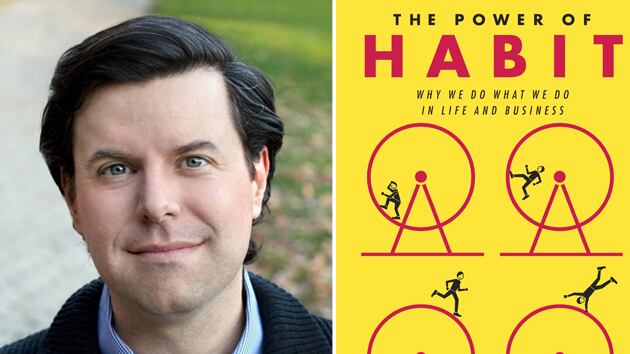If you punch “self-help” into Amazon, you’ll get something like 294,000 results. We are a people profoundly concerned with improving our weight or athletic performance or sex lives, always looking for easy fixes, for effortless ways to change our most ingrained habits. Much of what is offered is pseudoscientific at best, of course, but that hasn’t stopped an ever-growing army of charlatans from extracting millions from those of us who are desperate to improve ourselves.
In The Power of Habit: Why We Do What We Do in Life and Business, New York Times investigative reporter Charles Duhigg brings a heaping, much-needed dose of social science and psychology to the subject, explaining the promise and perils of habits via an entertaining ride that touches on everything from marketing to management studies to the civil-rights movement.
The book’s three sections cover the habits of individuals, organizations, and society, and all three are underpinned by Duhigg’s fundamental belief that habits can usually be changed: “simply understanding how habits work—learning the structure of the habit loop—makes them easier to control,” he writes. “Once you break the habit into its components, you can fiddle with the gears.”
Duhigg offers a clear, convincing account of how we come to engage automatically in behaviors that range from buying certain brands to taking bites of food from our kids’ plates when we’re not even hungry—and how we can stop doing so. He frequently focuses on how companies profit off our habits, from computer programs crafted to determine which new pop songs we’ll be unable to resist to the creepily accurate “predictive analytics” statistical modeling used by Target and other retailers to aggregate detailed profiles of tens of millions of shoppers’ buying habits. The Power of Habit often comes across as a hybrid of two recent releases: the excellent Thinking, Fast and Slow by Princeton Prof. Daniel Kahneman, and the good Brandwashed: Tricks Companies Use to Manipulate Our Minds and Persuade Us to Buy by marketing guru Martin Lindstrom. Like Kahneman and Lindstrom, Duhigg has a knack for distilling laboratory findings into accessible language that readers will find quite useful in navigating their daily habits and purchasing decisions.

Duhigg stumbles, however, when he occasionally presses his case a bit too hard. In big, complicated systems and events, it’s difficult to convincingly pin a given outcome on good or changed habits rather than to myriad other factors (luck foremost among them), and Duhigg isn’t always as rigorous as he should be on this front. Claims he makes about former NFL coach Tony Dungy and former Treasury secretary Paul O’Neill are prime examples.
Dungy transformed the culture of the previously moribund Tampa Bay Buccaneers in the late 1990s and early 2000s before taking the reins in Indianapolis and leading the Colts to a Super Bowl victory in 2007. He accomplished all this, Duhigg writes, by installing a system predicated not on sophisticated offensive or defensive schemes, but rather on getting his players to respond immediately and instinctively to any situation they encountered on the field—to react out of habit.
But Duhigg stretches things. In describing the game-sealing interception by Colts cornerback Marlin Jackson in the Colts’ win over the New England Patriots in the 2006–07 AFC championship game, he writes that Jackson “looked at his cues: the width of the gaps between the Patriot linemen and the depth of the running back’s stance. Both told him this was going to be a passing play.”
Well, no. Jackson knew Tom Brady was throwing the football because the Patriots had to go 45 yards in 24 seconds (not 17, as Duhigg writes), and no NFL team would possibly run the ball in that situation. The habits instilled by Jackson’s very talented coach had nothing to do with it.
Duhigg makes a similarly flimsy claim in recounting O’Neill’s early stint in government, when he had the somewhat counterintuitive idea of reducing infant mortality in America by beefing up college biology curricula. O’Neill realized that educating young mothers about nutrition was a key to reducing premature births and in turn infant mortality. But at the time, “many high school teachers in rural areas didn’t know enough about basic biology to teach nutrition,” so targeting future teachers in college seemed like the best bet.
Duhigg strongly implies that this was a turning point: “Today, the U.S. infant mortality rate is 68 percent lower than when O’Neill started the job.” Yes, but was it really O’Neill’s insight, which would have required the federal government to somehow alter the curricula of countless colleges? There are many other factors that could have helped reduce the rate of infant mortality over the span in question, and Duhigg offers no evidence in support of his preferred explanation. O’Neill himself seems to disagree with Duhigg’s analysis—the notes at the back of the book reveal that O’Neill sent an emailed response to a fact-checking question which read in part, “I would not take credit for our society doing a better job in reducing infant mortality.”
Though these questionable claims are distracting, they don’t really detract from the book overall. On the whole, The Power of Habit is a fascinating read, and Duhigg deftly pulls off exactly what one would expect of a polymath Times reporter: he effortlessly brings us from scene to scene, from finding to finding, from discipline to discipline, transforming a potentially dry subject into a series of peppy narratives—a very readable take on a subject that should matter to everyone.






